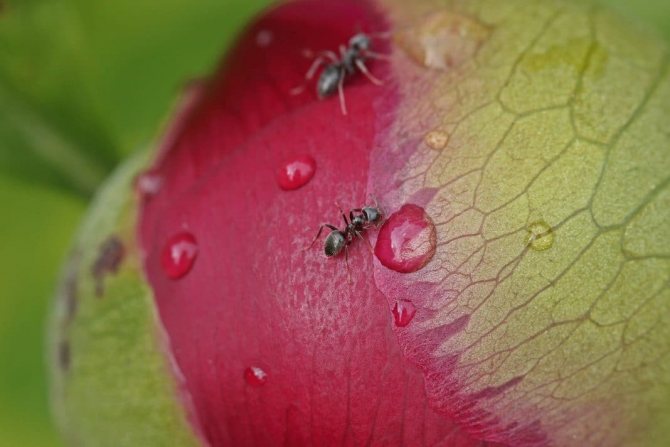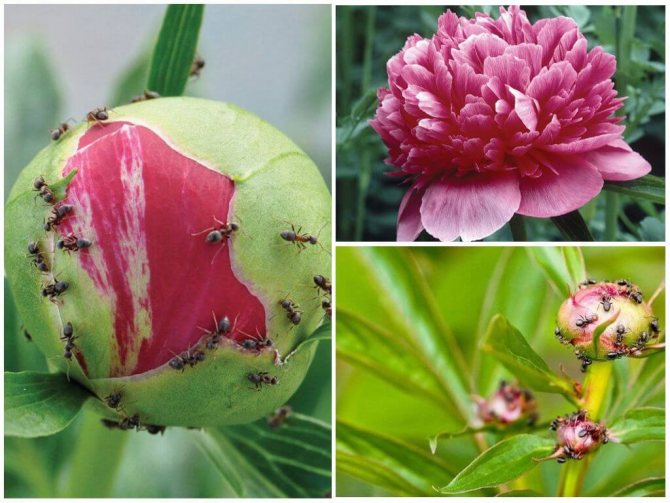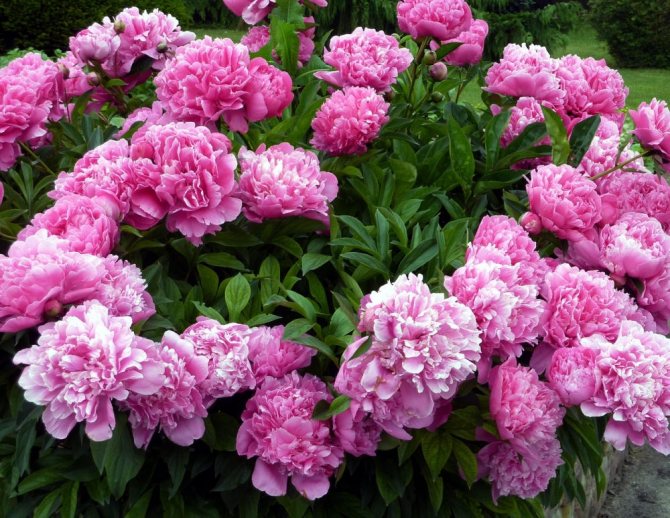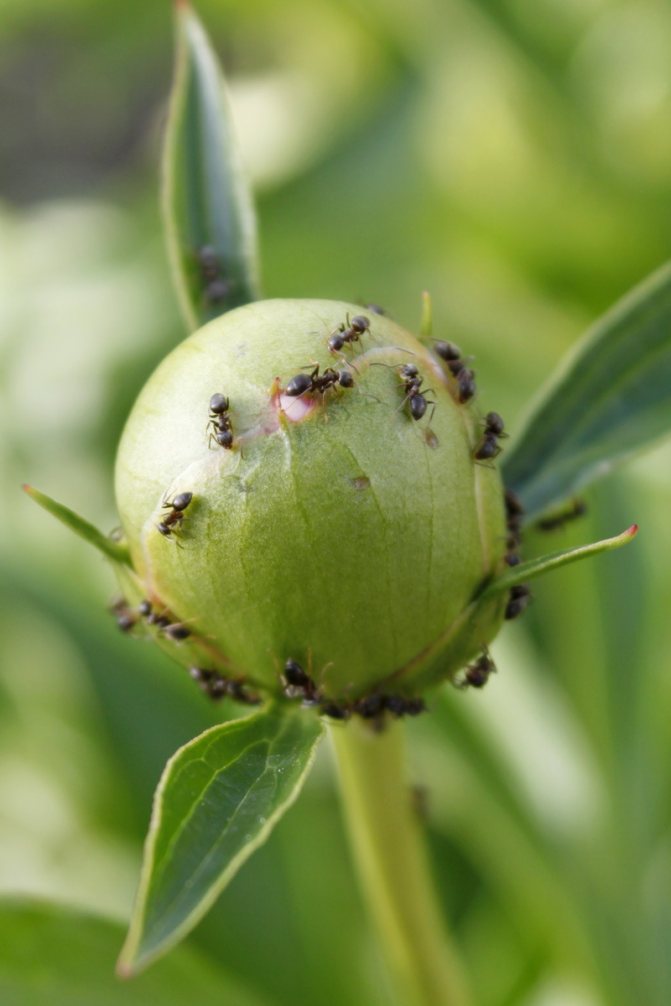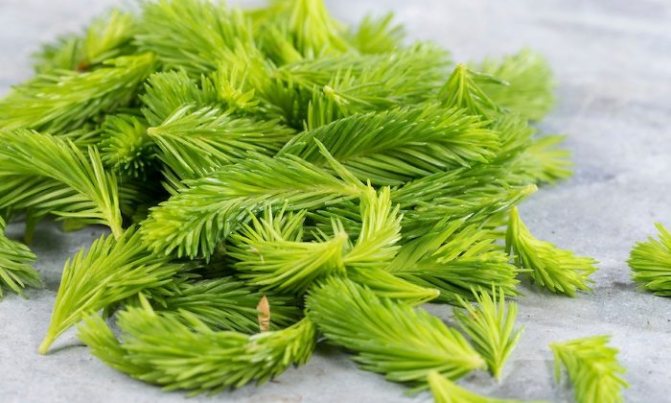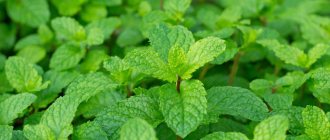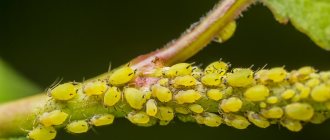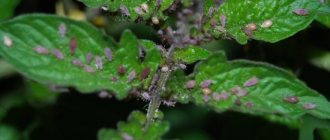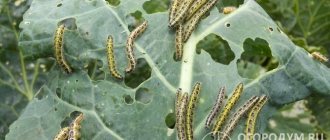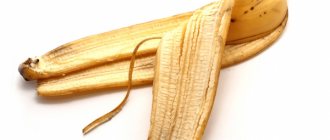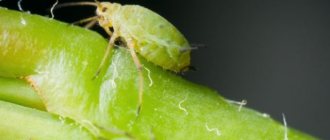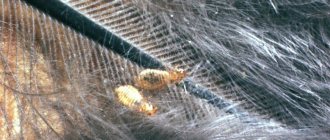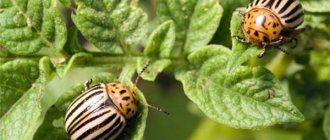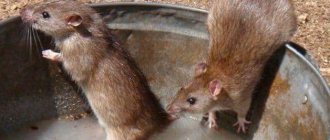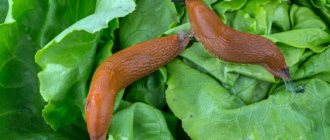A bush of peonies is a decoration of any garden and suburban area, the aroma of these flowers is unique. But if you look closely at the buds, you can see a large number of ants on them. But is it necessary to fight ants on peonies in natural conditions, the opinions of gardeners on this issue were divided into pros and cons.

Growing peonies. Illustration for this article is used under a standard license.
Why do ants appear on peonies
These flowers have many pests - bronze beetles, caterpillars, rootworm nematodes, sod and black ants. Many gardening experts and hobbyists with many years of experience in growing them believe that ants do not cause serious harm to plants. They just eat nutritious and tasty juice, but do not interfere with the growth of flowers.
But in an effort to get to such a desired treat, insects often spoil plants. Therefore, it is better not to allow them to appear on the buds. If this has already happened, it is necessary to deal with pests. For the process to be effective, it is important to establish the reasons for the appearance of ants. There can be three of them:
- Search for delicious food. A pleasant, sweetish and strong aroma attracts insects from afar, indicating the presence of a large amount of tasty food.
- Arrangement under an anthill bush. If the house is next to a peony, then for food they will first go to it, as to the nearest source.
- The presence of aphids on leaves, petals and buds. Aphid milk is another attractive food for ants.
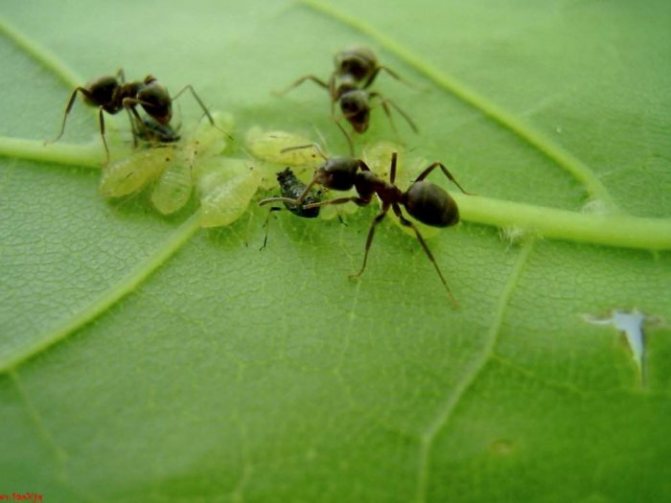

If there are aphids on the peonies, then soon there will be those who protect it - ants
Peonies are valued not only for their decorative effect, but also for their amazing aroma. It is he who attracts ants, which feed on the sweet nectar of the buds (this is a valuable source of carbohydrates for them). At the same time, insects generally do not interfere with the growth of peonies, only in some cases gnawing the cups of the buds that have not yet opened, as a result, the flowers are deformed or dry out.
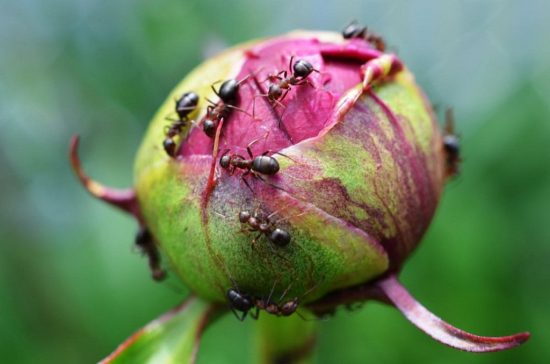

The peony bush will not seriously suffer from ants, but the presence of insects still affects its decorative effect; another problem is how to cut flowers so as not to bring them into the house
A more serious danger is the stable symbiosis of ants and aphids. They also "breed" it for food. Aphids are almost a universal garden pest that massively attacks fruit trees, shrubs, flowers, even greenery.
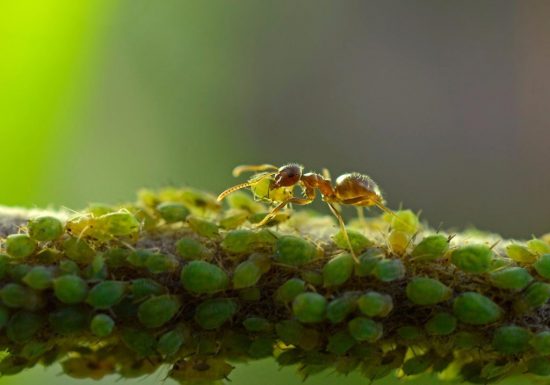

Where there are ants, sooner or later aphids appear - and this is already a big problem for the garden.
What is the danger of ants to peonies
Ants are almost not dangerous to blossoming peonies. They feast on the juice of flowers without gnawing their petals. The unopened buds of ants, trying to penetrate deeply, eat up strongly. As a result, the flowers may not bloom, and even if they do open, they will look non-decorative.
Cut the peonies covered with ants and bring them into the house, too, hardly anyone wants to. If you are growing flowers for sale, then it will be difficult for you to sell goods that are attacked by insects.
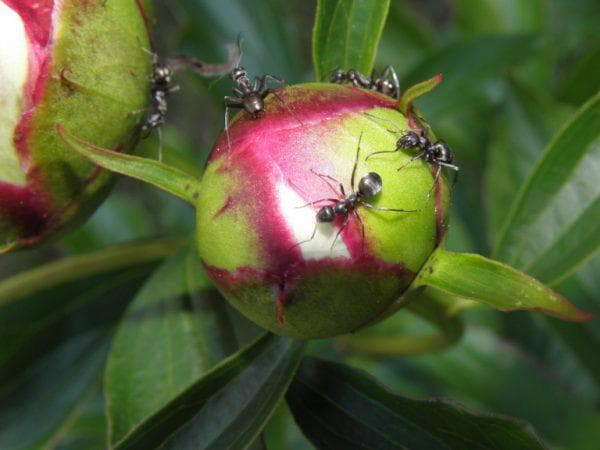

Another danger of ants on peonies threatens not only the flowers, but the entire garden: ants are the "breeders" of aphids, which cause serious damage to plants and are very difficult to remove.
The conclusion is obvious: if you find ants on peonies, you need to get rid of insects urgently. This can be done using insecticidal or folk remedies.
Boric acid
This pharmaceutical agent is poisonous for insects. 2 tbsp. l. powder mix with 2 tbsp. l. honey or jam and dilute with water to a semi-liquid state. Place the bait near the anthill.
You can use another method - pour boric acid on refined sugar and spread the sugar cubes under the peony bushes.
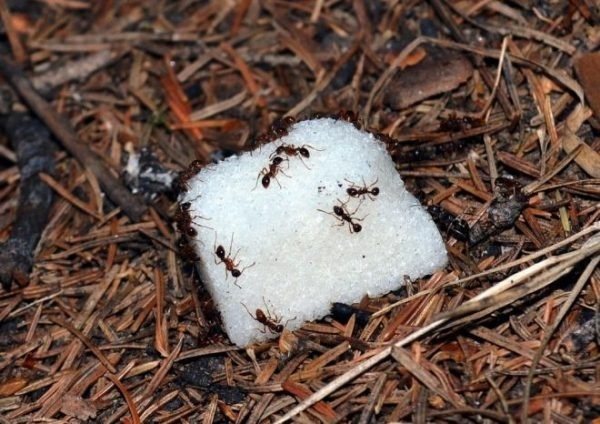

Chemicals


The modern chemical industry produces a variety of poisons that are effective against ants. Most of them, entering the insect's body, cause its death from paralysis, but before that, the ants that have eaten the poisonous bait manage to infect a huge number of congeners, due to which the entire colony dies out over time.
Such preparations are available in the form of aerosols, which can be sprayed on a plant attacked by pests, or powder and granules, scattered in places where ants congregate and along their favorite passages. In a similar way, a gel is used, which is drip applied to cardboard, spread out around the anthill and flower bushes, next to the ant paths. Many products need to be diluted with water, the resulting solution must be treated with peonies and watering the soil around the bush.
Some of the most effective chemicals used to control ants on peonies include:
- "Anteater" (analogs - "Muratsid", "Muravyin") is produced in granules;
- Expel is available as a solution or powder.
- "Pyrethrom" - a natural insecticide based on Dalmatian chamomile, produced in the form of a powder for solution preparation;
- "Antimuravei" is a borax-based preparation produced in granules or blisters filled with powder;
- gels "Raptor", "Tiratsid", "Kombat", "Great Warrior" and others, most often sold in tubes in the form of syringes for more convenient application;
- "Karbofos", "Fufanon" - insecticides of a wide spectrum of action, peonies can be treated with them no more than twice a season;
- "Fas-Double" - a solution is prepared from the powder, sprayed along the ant paths. The product is toxic, you can work with it only with a respirator and gloves;
- "Summer resident" - the substance is poured directly into the anthill, in which a depression is made before that;
- "Agran" is a concentrate for solution preparation, effective not only against ants, but also against a number of other insects.
We suggest that you familiarize yourself with: Fufanon for bedbugs - instructions for use
Chemical insecticides are effective but not safe for humans. They pose an even greater danger to pets. For bees and other insects that pollinate plants in the garden and vegetable garden, these preparations are no less destructive than for ants.
If there are pets in the house, you should pay attention to the poison released in the form of traps. They contain a poisonous bait to which the ants can easily penetrate. It is out of reach for cats and dogs.
Ways to get rid of aphids
Often, the invasion of hordes of ants is accompanied by the appearance of aphids, which often cause more damage to the plants. You can deal with them in the following ways:
- a decoction of pine or spruce cones;
- infusion of dandelion roots;
- vinegar essence;
- garlic.
Important! Any of these improvised means will effectively protect plants from aphids.
Pine or spruce needles
Pine or spruce broth is good for warding off aphids. To prepare it, you need to pour two kilograms of the component with eight liters of water. All ingredients must be mixed and kept out of direct sunlight for a week. The liquid must be stirred periodically.
After infusing the product, it is diluted with water in proportions of 1 part of the substance to 10 parts of water. The mixture can be sprayed daily on soil and bushes.To completely get rid of insects, you need to spray the plants for three days twice a day. After a while, you can repeat the preventive measures.


Dandelion root infusion
Dandelion roots can also easily kill insects. To do this, you need to pour three hundred grams of plant roots along with 400 grams of leaves with ten liters of water at room temperature. After three hours, the tincture will be ready. She can be sprayed with peonies from different types of ants.
Vinegar essence
Vinegar is another remedy that has been used effectively to combat ants. To do this, a liter of vinegar is mixed with two glasses of vegetable oil. The mixture is well mixed and poured into the holes that serve as entrances to the ants. Then the insect dwelling is covered with a film for three days. During this time, all pests will die.


Garlic
Garlic can be used to control pests. You can take a garlic wedge and cut it in half. Then rub the plant well along the trunk. A piece of cloth moistened with kerosene left near the plant will have similar properties. It will also repel insects. The only disadvantage of using the second option is that many do not like the smell of kerosene.
How to remove an anthill from under a peony bush
If an anthill is located directly under the roots of a peony bush or nearby, then it is logical that the ants "master" it (as the closest food source). A small (up to 30–40 cm) diameter anthill can be moved without causing much damage to insects. They just dug it out with a shovel, put it in a wheelbarrow and take it away from the site, somewhere in the forest. Sprinkle the soil with ash, baking soda, or salt to get rid of any leftover individuals.
A less humane way is to fill the anthill with a solution of baking soda (a pack of 10 liters of water), ammonia (100 ml for the same volume), soap (250 ml of liquid soap or 200 g of shavings, a liter of vinegar and half the size of any vegetable oil). The liquid is poured into the anthill and covered with a plastic bag for a day, pressing the edges tightly to the ground.
Bay leaf
With the help of a bay leaf, you can also save a flower garden from ants. It is necessary to prepare an infusion for processing buds and foliage.
Pour 10 g of laurel leaf with 1000 ml of boiling water and cover the container with a lid. When the infusion has cooled, process the bushes with a spray bottle, or use a cotton swab and grease the buds with laurel infusion.
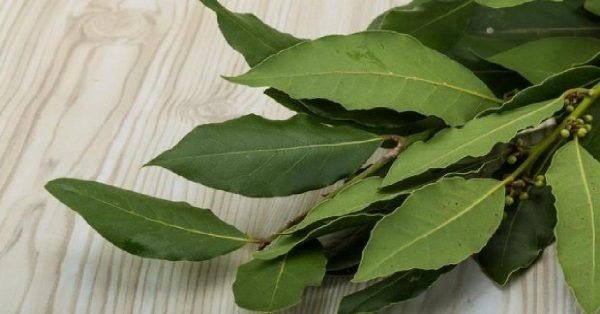

Folk methods of fighting ants on peonies
Many gardeners prefer to use folk remedies to control insect pests, which are cheaper and safer compared to specialized chemicals. Several methods are used to get rid of ants on peonies.
- Vaseline barrier. Ants can't stand the smell of petroleum jelly. If you cut a circle out of cardboard, make a hole for the stem in the center, make an incision and put the circle on the stem of a peony, lubricate the cardboard ring from below with petroleum jelly, then ants will not be able to overcome this obstacle. The only drawback of the method is that such rings do not add decorativeness to the peony bushes.
- Garlic. Arrows of garlic can be spread around peony bushes. The flowers themselves are sprayed with garlic infusion. The goal is to scare away ants with a pungent smell of garlic. In the same way, you can use wormwood, tomato tops. The disadvantage of this method is an unpleasant odor, which prevents the grower himself from enjoying the beauty of peonies.
- Sweet baits with boric acid. Boric acid for ants is a fast-acting poison. If you mix it with jam, honey, sugar and other sweets and spread it in places with a large concentration of ants, they, eating the delicacy, will die in just a matter of seconds. Some people simply pour sugar cubes with a boric acid solution and lay them out under the peonies.Such a tool will only get rid of some of the insects. It is not always possible to drive ants away from peonies in this way. But on the site there will be much less of them.
- Baking powder for the dough. Upon contact with acid, it causes a reaction in the ant's body, from which it dies. Works only dry. Instead of baking powder, you can use baking soda, which does not lose its effectiveness in the form of a solution.
- Coca-Cola and similar drinks. If you stir up an anthill and pour in a popular drink, the ant eggs will be destroyed. Faced with such hostile treatment, ants are more likely to leave your garden plot while leaving your peonies alone.


The above folk methods of fighting ants on peonies are the most popular and affordable. They are quite effective, but the result from their use is incomparable with the use of specialized chemicals.
The appearance of ants on peonies is an alarming sign. They are able not only to make flowers less decorative, but also to cause significant damage to other plants in the garden and vegetable garden. To get rid of insects, chemical and folk remedies are used. Each method has its own advantages and disadvantages.
What if you are bitten by an ant?
And finally, let's talk about what to do if, during a difficult struggle, several small ants did not hesitate to "bite" your hand or other part of the body. In temperate latitudes, an ant bite is not dangerous, but can be quite painful. A man is usually bitten by war ants with a large head and powerful jaws.
A slight itching caused by a single bite disappears after a few hours and does not pose a danger to humans. It is much worse if an allergic reaction develops, the signs of which are the following symptoms:
- the appearance of swelling, blisters, itching;
- extensive redness of the skin, accompanied by pain;
- nausea, shortness of breath, headache, loss of consciousness.
Treatment for ant bites is as follows:
- wipe the bite with a drug containing alcohol;
- Apply a baking soda compress to relieve itching.
- remove the swelling that occurs with several bites using a compress from steamed birch leaves or raw potato gruel;
- take antihistamines;
- if severely injured, consult a doctor.
Prevention measures
Simple preventive actions will help you not to face such a problem as ants on peonies:
- regularly treat buds with insecticides or insect repellents;
- do not allow the construction of an anthill at the roots of peonies or immediately transfer it to another place;
- if you are going to plant plants where the anthill used to be, dig up the soil, mixing it with ash;
- plant mint, lavender and other herbs that ants don't like the smell of along the borders of the site or anywhere else;
- in the spring and summer, carry out activities to protect the entire garden from ants and aphids.
Simple activities will help you never face a problem:
- every year in mid-April and October, treat the area around the perimeter with suitable insecticides or plant plants whose smell is unpleasant for ants;
- regularly inspect peonies in order to find the anthill in time - when it can still be moved without resorting to "heavy artillery";
- When planting flowers where the anthill used to be, carefully dig up the soil by adding wood ash (0.5 l / m²) to it.
Preventive actions
To prevent the appearance of pests on peonies, it is enough to adhere to basic rules:
- once a week, apply chemical agents that kill or repel insects to bushes with flowers;
- eliminate the formed anthills at the base of flower bushes, preventing their growth;
- when planting plants in an area where ants previously lived, the soil should be well dug up and mixed with wood ash;
- it is recommended to plant lavender or mint on the site, since the smell of these plants scares off pests;
- in spring and autumn, mass processing of the entire site from pests should be carried out.
Peonies are unpretentious and can decorate any area. With timely implementation of measures to protect against insects, the bushes will not lose their attractiveness and will only increase the intensity of flowering.


